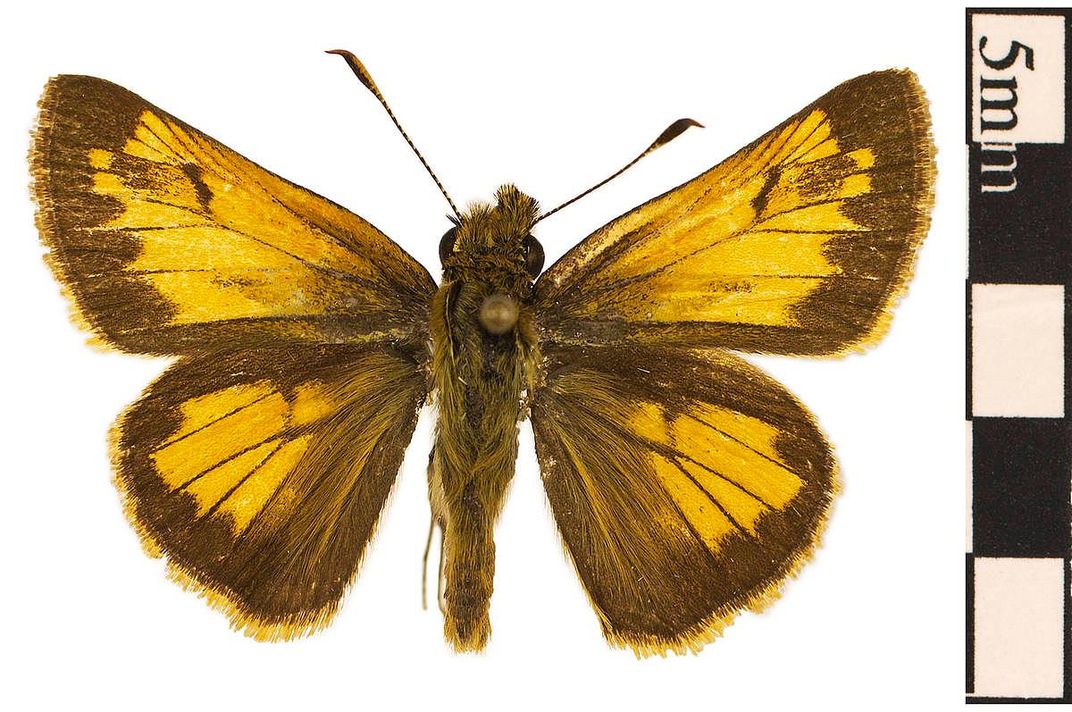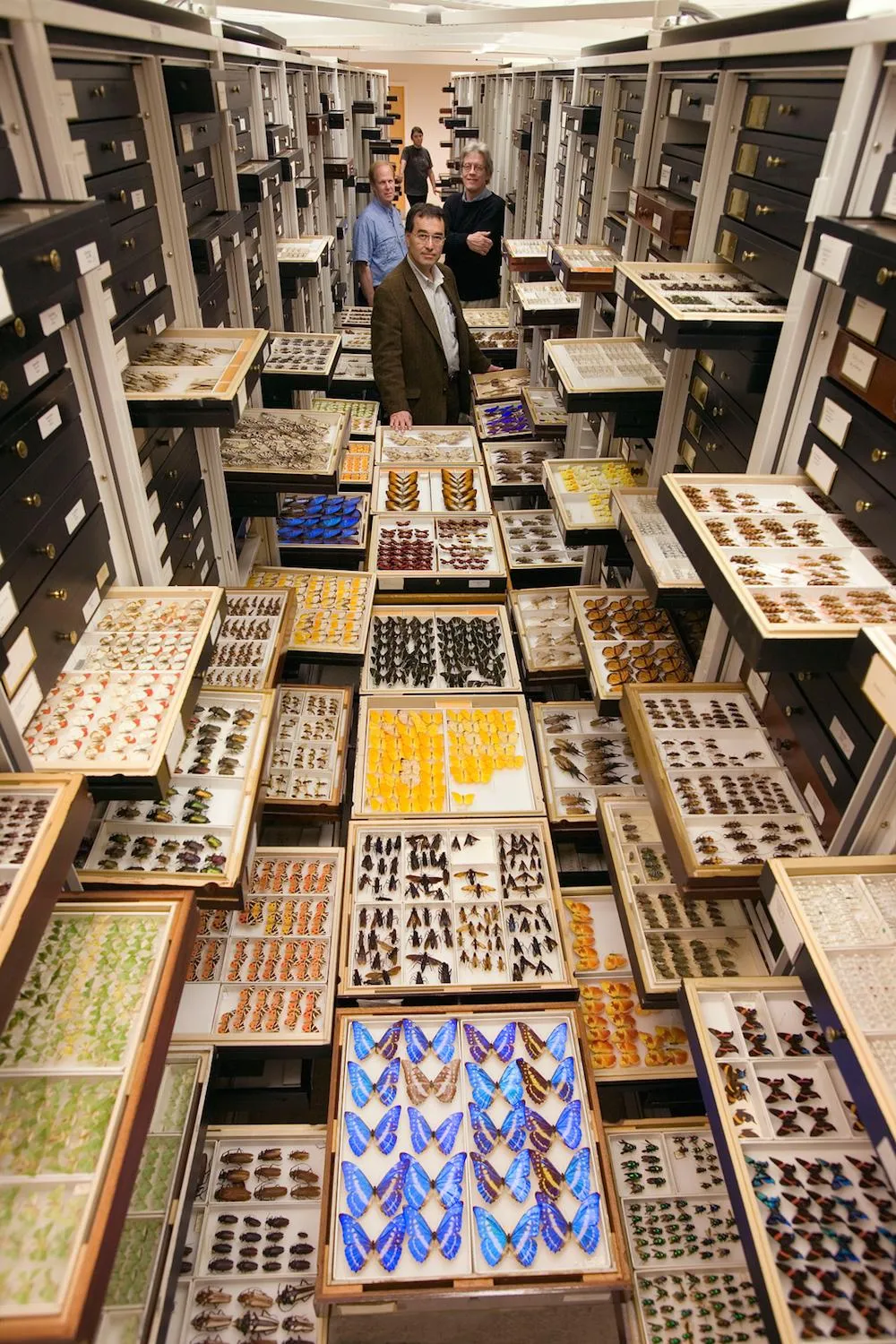One of the ‘Rarest Butterflies Ever’ May Have Been a Moth All Along
A species description from more than two centuries ago has fooled scientists until now
:focal(1000x1047:1001x1048)/https://tf-cmsv2-smithsonianmag-media.s3.amazonaws.com/filer/92/da/92daaf79-0d04-4e26-a458-205533d589f8/bmnhe_1377146_eusemia_contigua_walker_crop.jpg)
In the latter part of the 18th century, Johan Fabricius was busy churning out scientific names for new insects. A student of the so-called father of modern taxonomy, Carolus Linnaeus, and one of the most productive entomologists in history, Fabricius put monikers to about 10,000 species. We have him to thank for classifying orders (though he called them classes) of insects based on their mouthparts—a practice that is still used today.
Fabricius’s penchant for classification meant he was often on the move, traveling between various countries to examine specimens in museums and private collections. At some point during his globetrotting, Fabricius examined insect illustrations made by William Jones, an English entomologist who drew a number of specimens from various collections. These pictures led Fabricius to publish a description in 1793 of a butterfly species of uncertain origin—a paper that everyone promptly forgot, according to Alberto Zilli, a moth curator at the Natural History Museum in London.
Fabricius first described Hesperia busiris as a butterfly in the skipper family. In Jones’ drawing, the antennae have a well-developed club at the end similar to other skipper specimens, but the shape of the wings and the wing and body pattern look nothing like other species in the family. Since a second specimen of this butterfly was never discovered, Hesperia busiris was included in a number of subsequent butterfly catalogues over the years.
The trail of this missing mystery butterfly—which has likely since gone extinct—has eluded biologists for 200 years despite the specimen passing under the scrutiny of some of the most famous entomologists of the 18th century. But academic detective work by Zilli and his colleague may have finally revealed the identity of the elusive insect.
In a study published recently in Systematic Entomology, Zilli and Nick Grishin, a butterfly researcher at the University of Texas, examined illustrations and engravings from centuries past and tracked the movement of specimens through museums and private collections to solve the mystery of the missing butterfly. “Hesperia busiris, one of the ‘rarest butterflies ever,’ eventually proved to be a moth, although no less a rare one, entering the ranks of moth species known only from unique specimens,” the study concludes.
**********
More than 200 years after Fabricius first described what he thought was a butterfly, Zilli was at a conference in Indiana in 2015 when Grishin showed him a photo of a specimen he’d found online in a collection digitized by the Oxford University Museum. Grishin asked Zilli if he knew what it might be. The insect was supposedly a butterfly from the skipper family, almost two inches wide and very colorful, with bright orange and yellow spots surrounded by black borders.

Zilli “soon recognized a group of gaily colored moths” called Agaristinae, he says. Grishin agreed that it didn’t look like a skipper, and back in the U.K., Zilli went to work examining specimens stored in the drawers of London museums. These insects may have come from the collections of Dru Drury, a silversmith and entomologist who amassed a collection of more than 11,000 insect specimens from around the world, some of which were illustrated by Jones—including, researchers believe, the original “butterfly” drawn by Jones and described by Fabricius.
“It became this error that was reinforced over time because no one had access to the original specimen,” says Floyd Shockley, a collections manager in the Department of Entomology at the Smithsonian’s National Museum of Natural History.
After personally examining thousands of species of butterflies, phoning museums and asking about their unpublished and recent African holdings, Zilli could only find one example that matched the original drawing of the “butterfly.” The trouble was that the holotype (the single species on which a description is based), housed in the Natural History Museum in London, was listed as Eusemia contigua—a moth described by the prolific entomologist Francis Walker in 1854.
Shockley says that misclassification and confusion happens more often than people might think. “It’s almost always involving taxa that were described very, very early.”
Some of the disarray is due to outdated naming conventions that were less specific or a more lax description of samples. Many insects described before the 20th century are simply listed as coming from “America” or “Africa” with little accompanying information about season, ecosystem type, or even a more specific geographic location.
Other times, Shockley says, the original type specimen is destroyed or mangled at some point. The specimen Zilli found in the London museum was missing an antenna that showed up in the 18th-century drawings made by Jones, and the genitalia and abdomen had been detached and mounted separately. More research into the specimen’s history revealed that it came from the collection of another insect enthusiast named George Milne, a butterfly and moth collector about whom little else is known. Milne bought a great deal of specimens from the Drury collection in 1805. While it’s possible the Eusemia contigua holotype that Zilli found is a second specimen, he says that, based on the features of the insect and archival documentation of its accession at the museum in London, it is far more likely the same individual drawn by Jones and described by Fabricius in the 18th century.
In other words, the same individual insect that Johan Fabricius identified as a butterfly in 1793 was likely acquired by the Natural History Museum in London and classified as a moth by Francis Walker about 60 years later. Until now, as far as butterfly taxonomy was concerned, the specimen had simply disappeared.
“We went through collections of museums and checked all the literature. We couldn’t find any record of a second specimen,” Zilli says, adding that Jones may have taken artistic liberty by drawing the second antenna (or it was lost over the centuries) and that the abdomen had been later removed and mounted onto a microscope slide.

Walker probably never realized he had double named a species already described by Fabricius as a butterfly. “[Walker] was just cranking out species descriptions as fast as he could because that’s how he made his living,” Shockley says. Regardless, his description rang a little closer to the species’ true identity since he at least recognized it as a moth from the Eusemia genus. The missing butterfly, it seems, had never existed at all.
**********
Zilli and Grishin propose in their study that the name of the insect be changed to Heraclia busiris, matching the original name given by Fabricius to the Heraclia genus of moths in Africa that the insect likely belongs to.
Robert Anderson, a research entomologist at the Canadian Museum of Nature in Ottawa, says the new study is “one of those situations where someone’s gone and done a lot of detective work to try to piece one of these things together.” The work illustrates the importance of museums keeping repositories of holotype samples, allowing researchers to return to old specimens and confirm their original types. Insects have only one holotype for a given species.
Specimens sitting in museum storage drawers often hide secrets. Anderson discovered an entirely new genus of weevils from a specimen he examined in a collection at the Mississippi State University* that had come from an expedition a student took to Panama 35 years earlier. Digitizing some of the holotypes can help researchers sort these issues out without the need for trips to far-flung universities—indeed, Grishin only came across Jones’ drawing when the original was digitized by the Oxford University Museum.
According to Zilli, the butterfly-turned-moth is likely extinct, although he hopes otherwise. The specimen fits with other similar species from Africa, and some clues point to it having come from Sierra Leone, in which case it would have been initially collected by Henry Smeathman, an abolitionist who lived in the area for several years collecting insects and who, contradictorily, also received support from individuals in the slave trade.
Some evidence suggests that the insect in question came from the Coromandel Coast in the southeast of India. Zilli and Grishin note that deforestation is so extensive in both these areas that the likelihood of the species surviving is low.
While anything is possible regarding its origin, Zilli says that “being so colorful, and such a species that people collect often all over the world, a second specimen should come up.” Since another individual has not been found, the single museum holotype may represent the only surviving record of this “gaily colored” moth.
While some species disappear without leaving a trace, museum specimens can help scientists peer into the past to learn how the natural world has changed in just a couple hundred years. Who knows what other missing or unknown species remain locked away in drawers, pinned to mounting boards among thousands of specimens. There could be another insect like Heraclia busiris, formerly known as Eusemia contigua and before that, Hesperia busiris.
“This is a case study for showing what we are losing,” Zilli says. “For certain there are many more.”
*Editor’s Note, April 2, 2019: A previous version of this article incorrectly stated that Robert Anderson discovered a new genus of weevils in the collections of the University of Mississippi, when, in fact it was the collections of Mississippi State University. The story has been edited to correct that fact.
/https://tf-cmsv2-smithsonianmag-media.s3.amazonaws.com/accounts/headshot/joshua-learn_copy.jpg)
/https://tf-cmsv2-smithsonianmag-media.s3.amazonaws.com/accounts/headshot/joshua-learn_copy.jpg)